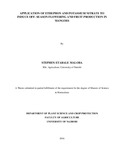| dc.description.abstract | Mango (Mangifera indica L.) is one of the most important orchard fruit trees in the tropics. In Kenya, mango is the third most important fruit crop cultivated mainly by smallholder farmers for domestic and export markets. Mango production in Kenya is seasonal, with high and low seasons. Oversupply of mango fruits during the high season is one of the factors that contribute to the high postharvest losses (≥50%) reported in the supply chain. Manipulation of mango trees through application of flower inducing chemicals is one strategy that can be used to address mango seasonality and ultimately address the high postharvest losses resulting from oversupply. The objective of the present study was to determine the effect of the off-season flower induction technologies (ethephon and potassium nitrate) on reproductive growth parameters and yield components of „Apple‟ and „Ngowe‟ mango trees under two different agro-ecological zones (AEZs) of Kenya namely, Embu County (a high potential AEZ) and Makueni County (a low potential AEZ). The study also sought to establish the effect of the off-season flower induction technologies on quality attributes of the mango fruits. Potassium nitrate was applied at two concentrations (2 and 4%), while ethephon was applied at three concentrations (300, 600 and 1000ppm) in the first experiment and at two concentrations (600 and 1000ppm) in the second experiment then compared to control (water). 300ppm ethephon was left out because it showed no much significance differences in most of the parameters tested in the first experiment. The treatments were applied to mango trees which failed to flower/set fruit in the 2013 and 2014 seasons. The test trees comprised of randomly selected 6 – 8 years old „Apple‟ and „Ngowe‟ trees of uniform in vigor and size. The spraying of the treatments was done on mature flushes one week after the leaves had attained a dark green color. One hundred (100) terminal shoots were marked randomly on each tree prior to spraying. After inflorescence development, 20 panicles per tree were marked randomly on each tree to establish fruit set. The experiments were laid out in a complete randomized design with three replicates and three trees per treatment where the three trees represented a replicate. Each replicate comprised of 18 and 15 trees in the first and second experiment respectively. Effect of the treatments was established from reproductive growth parameters including days to flowering and fruit set, number of panicles per tree and average fruit set per 20 panicles. Other responses of the trees to the treatments such as fruit fall and hormonal effect (internal ethylene in young fruits) were also evaluated. Tree ripe fruits (50 fruits) were sampled from treated and untreated trees, and the effect of the treatments on various fruit quality attributes: major sugars, vitamin C, beta carotene, total soluble solids,
and total titratable acidity determined. The results from the effect of the treatments on reproductive growth parameters, yield and yield components of mango trees showed that Potassium nitrate (4%) increased percentage flowering (% of tagged shoots) in both „Ngowe‟ and „Apple‟ in both AEZs. Response to ethephon increased with concentration with the 1000ppm giving the best response. Time to flowering was significantly shortened by both KNO3 and ethephon treatments with „Ngowe‟ being more responsive than „Apple‟. Significant treatment effect (p≤0.05) was observed on fruit set with 4% KNO3 and 1000ppm ethephon resulting in the highest fruit set in both AEZs and varieties. Potassium nitrate and ethephon treatment had a significant (p≤0.05) effect on total number of fruits per tree. There was significant interaction (p≤0.05) amongst treatments, production location and the varieties. Although KNO3 and ethephon affected some of quality attributes evaluated, most of the observed differences were not consistent. The differences could partly be attributed to the inherent varietal differences in „Apple‟ and „Ngowe‟ and the differences in agro-ecological conditions in Embu and Makueni. However, significant treatment effect was observed in some of the quality parameters. In beta-carotene, significant (p≤0.05) treatment effect was observed in trees treated with 2% KNO3, 600 ppm and 1,000 ppm ethephon where beta-carotene levels averaged 1.5, 1.6 and 1.7 mg/100 ml respectively compared to 1.4 mg/100ml in the untreated control. Regardless of variety or location, slightly higher vitamin C levels (average 93 mg/100 ml) were reported in KNO3 treated trees compared to those treated with ethephon (86.8 to 90.2 mg/100 ml. The trend in total soluble solids and sugars was inconsistent with the AEZ and variety showing the greatest effect. The findings show that potassium nitrate and ethephon can be used to induce flowering and fruiting in mango fruits without negatively affecting the fruits‟ quality attributes. These technologies can therefore be applied to induce off-season fruit production in „Apple‟ and „Ngowe‟ fruit as a strategy to address seasonality and reduce postharvest losses currently reported during the peak season due to oversupply. | en_US |



